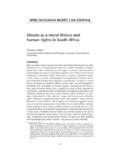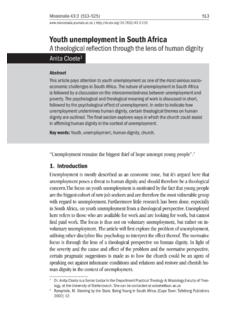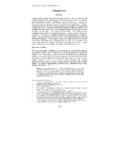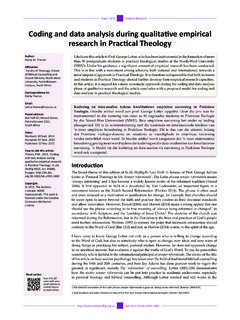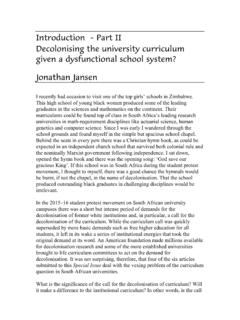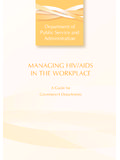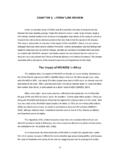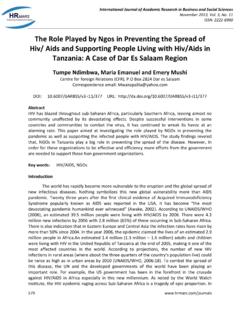Transcription of Reviewing gender and cultural factors associated …
1 Research ArticleReviewing gender and cultural factors associated with HIV/ aids among university students in the South African contextA van Staden, PhD (Psychology of Education)Senior Lecturer, Department of Psychology of Education, University of the Free State, Bloemfontein G Badenhorst, PhD (Psychology of Education) Senior Lecturer, Department of Psychology of Education, University of the Free State, BloemfonteinKev wordsHIV/ aids , culture, gender , high-risk sexual behaviour, South African stu dentsCorrespondence addressAnnalene van Staden Department o f Psychology o f Educa tion,Faculty o f Education,University o f the Free State,Abstract: Curationis 32 (4): 19-28 South Africa is in the m idst o f a catastrophic aids epidemic. HIV prevalence statis tics in most countries indicate that up to 60% o f all new infections occur among 15 to 24 year olds, whilst this group also boasts the highest incidence o f sexually transm it ted infections (STIs).
2 Statistical findings among South African students predict a 10% increase in the HIV infection rate, highlighting the inability o f universities to cope with societies demands for academically trained workers which, in the near future, will have a detrimental effect on the economy o f South Africa. From the literature it is evident that HIV/ aids is more than a health issue, it is an inter-sectoral challenge to any society. This paper explored the interplay o f gender and cultural factors on South African students sexual behaviour by inter alia discussing the following factors that might put students at risk for HIV infection: male dominance vs. female submissiveness; age o f first sexual encounter; gender -based violence; contraception; circumcision; financial status; myths and othering ; demonstrating the need for effective strategies, policies and programmes to protect young people, especially females from sexual abuse/rape and its consequences, including HIV.
3 The literature review revealed that South African students, despite adequate HIV/ aids knowledge, dem onstrated high rates o f sexual practices that place them at risk for HIV infection, unprotected sex, multiple partners and sugar-daddy practices . The paper concludes with a discussion on recommendations for future HIV preven tion/intervention programmes, highlighting the fact that it acquires an inclusive ap proach. Such interventions should move beyond the individual level to be effective and target gender -based inequalities, human rights violations, including sexual vio lence and rape, as well as stigma and poverty reduction, both at com munity and tertiary educational : (051)446-0340E -m ail: December 2009 IntroductionThe Human Immunodeficiency Virus (HIV) and Acquired Immune Deficiency Syndrome ( aids ) pandem ic has re ceived overwhelming attention at all levels o f social intervention. Michael Gibbons, Secretary-General o f the A s sociation o f Comm onwealth Universi ties, warned that the HIV and aids pandemic would lead to the decimation o f higher education structures in South Africa (Bridgraj, 2000:9).
4 This means that universities will not be able to cope with society s demand for academically trained workers (Bridgraj, 2000:9). Look ing at the pandemic from this perspec tive helps us to realise the vulnerabil ity o f young adults, as well as the fact that HIV infection is spread through m odern sexual beh aviou r (M arcus, 2002:23).For m any students university life is an opportunity to experim ent and be ad venturous. Very often experimentation with sex, alcohol and drugs occurs dur ing their university years, lowering stu dents inhibitions and leading to riskier sexual behaviour and even date rape (Southern African Regional Universi ties Association, 2009:19). Recent data suggest that up to 60% o f all new HIV infections occur among young people in the age group 15 to 24 years, whilst this group also boasts the highest in cidence o f sexually transm itted infec tio n s ( S T Is ) o f all ag e g ro u p s (G ivaudan, L eenen, van de Vijver, Poortinga & Pick, 2008:98).
5 The exist ence o f HIV has certainly changed the situation from times when the possibil ity o f an unwanted pregnancy was all a student had to worry about after par ticipating in unprotected sexual activ ity (Thom & Cullinan, 2003:47).Problem statement and research questionsSeveral problems currently exist in the battle against HIV and aids among students. Abt Associates (in Levine & Ross, 2002:90) estimated that, in the year 2000, the HIV infection rate at univer sity undergraduate level was roughly 22%. Estimates for 2005 rose to about 33%. Tertiary institutions will therefore be c o n fro n te d w ith an in c re a sin g number o f students who will commence their studies as HIV-positive individu als, as well as an increasing num ber o fstudents who will be infected with HIV by the time they have completed their studies (Crewe, 2000:11). The negative impact o f HIV/ aids will result in stu dents never reaching senior levels in the economic work sector; thus directly affecting efforts directed at addressing structural problems, including high lev els o f unemployment, skills shortages and high levels o f income inequality (Comelissen, 2005:1).
6 Previous educational prevention pro grammes to combat HIV among stu dents focused on informing the youth about the modes o f transmission o f HIV (Strydom & Stiydom, 2002:216). Knowl edge, A ttitud e, B e lie f and Practice (KABP) surveys were mainly used to study stu den ts sexual behaviour in relation to HIV. The reason was that researchers believed if the youth could develop the proper skills and had the right information (facts) surrounding HIV and its modes o f transition and their beliefs (positive or negative feel ings and opinions) were taken into con sideration, it m ight help predict and in fluence their health-related behaviour, and would they be in the position to change their high-risk sexual behaviour (Badenhorst, Van Staden & Coetsee, 2008:106-120).A fter Reviewing recent research find ings, it became clear that, despite hav ing a sufficient knowledge base with regard to HIV and its modes o f trans mission to protect themselves, students still put them selves at risk for HIV in fection (Southern African African Re g io n a l U n iv e r s itie s A s s o c ia tio n , 2009:17-20; Akande, 2001:239).
7 This dem onstrates that knowledge alone is not enough to prevent HIV infection and that those factors such as gender and culture should also be researched to help stop the spreading o f HIV (Levine & Ross, 2002:90; Eaton & Flisher, 2000: 111; Coughlan, Coughlan & Jameson, 1996:255).Emanating from the above, the follow ing research questions guided this re search: To what degree do gender and culture influence high-risk sexual behaviour among stu dents at South African univer sities? To what degree do high-risksexual practices o f students dif fer on the basis o f gender , cul ture and their awareness o f HIV/ aids ?PurposeThe main purpose o f the present study is to review the South African litera ture on students sexual practices and high-risk behaviour in order to identify prevailing themes and trends so that new directions may be identified in the research on students and HIV/ aids prevention. Hence, in the present study the authors set out to: Explore the interplay o f gender and cultural factors on South African students sexual behav iour; Provide evidence that cultural and gender stereotypes still ex ist among South African stu dents; and Critically discuss other influ ences relating to gender and sexual behaviour and the pos sible effect thereof on South African students high-risk sexual of gender and cultural factors on South African students sexual behaviourStudies by the Departm ent o f Health (1994:14) and Trussler and M archand (1997:51) before 2000, as well as by the World Health Organization (2000:10,12) highlighted the importance o f HIV Pre vention Programming within the con text o f the cultural beliefs o f the target society.
8 Moreover, researchers maintain that unsafe heterosexual practices are the most frequently reported risk for HIV/ aids infection in South Africa (Uys & Alexander, 2002:296; Akande, 2001:239). It is for this reason that sexual practices are a logical starting point for HIV research in South Africa. It is, how ever, important to focus on understand ing sexual behaviour by placing it in a cultural context within the social milieu in which it occurs (Crothers, 2001:13- 16). The gender context is determined according to what is culturally defined as being feminine (appropriate female behaviour) or masculine (appropriate male behaviour) in sexual relationships (Ferrante, 2003:314). Research substan-20 Curationis December 2009tiates the importance o f gender (for in stance, the unequal division o f power) as an influence on health behaviour (Finchilescu,2002:109-131).The influence o f culture and gender on the sexual practices o f young adults is also demonstrated by the fact that re spondents p articipatin g in research studies (Badenhorst et al.)
9 2008:106- 123; Levine & Ross, 2002:98) admitted that a cultural basis for infection with HIV exists. Arguments revolve around statem ents that culture shapes both gender and what is considered the ideal form o f trust and intimacy in sexual re lationships. The following factors have been identified that may place students at risk for HIV infection: M ultiple partnerships, espe cially having m ore than one partner at the same time; Big age gaps between sexual partners; Not using condom consist ently; Not knowing you and your part n er s HIV status; The presence o f other sexually transmitted diseases; and Excessive alcohol use and binge drinking , which in creases risk taking behaviour.(South African Regional Universities Association, 2009:17).Studying the culture o f individuals in relation to their gender and sexual prac tices will shift the focus from a rational choice based on an individual response to guidelines focusing on cultural dif ferences (Ntlabati, Kelly & Mankayi, 2001:17).
10 Culture and gender influence a lot o f aspects surrounding students high-risk sexual behaviour with regard to HIV infection. These factors play a direct role in an individual s choice to use safe sexual practices to protect himself/herself against HIV. In addition, research findings suggest that gender inequality and gender -based violence are essential determinates o f w om en s HIV risk, worldwide as well as in South Africa (Dunkle, Jewkes, Brown, Gray, Mclntryre & Harlow, 2004:1415). Thus, in the next section the influence o f gen der relations and cultural habits on the sexual practices o f female and male stu dents will be discussed by investigat ing the interplay o f factors such as male dominance vs. submissiveness, age offirst sexual encounter, gender -based violence, contraception, circumcision, financial status, myths, as well as the concept of othering .Male dominance vs. female submissivenessMale and female roles are often shaped by society, culture, the immediate and extended family, communities and indi vidual decisions (S outhern A frican R e g io n a l U n iv e rs ity A s s o c ia tio n , 2 0 09 :19 ).

